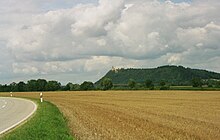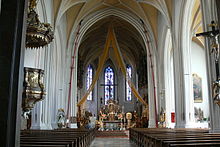Bogenberg pilgrimage church
The pilgrimage church of the Assumption of Mary on the 432 meter high Bogenberg near the Lower Bavarian town of Bogen is an important Catholic pilgrimage site in the diocese of Regensburg . It is considered the oldest Marian pilgrimage church in Bavaria. For this reason, the Bogenberg, rising 118 meters above the Danube , is also known as the Holy Mountain of Lower Bavaria .
History of the pilgrimage
In the vestibule of the church a stone tablet tells about the origins of the pilgrimage. Accordingly, the miraculous image floated on the Danube in 1104 and was set up by Count Aswin von Bogen in his castle chapel . In 1223 the Bogenberg was named "Mountain of St. Mary" in a document from Pope Honorius III. mentioned. In 1286 Bishop Bernhard von Passau and in 1294 Bishop Enicho von Freising awarded indulgences for the pilgrims on the Bogenberg.
In 1295 a new church was built, and next to the church the Oberalteich monastery , which had been responsible for the pilgrimage from the start, built an apartment for the monks , which later became the Bogenberg priory . Today's church was built in 1463 under Prior Benedikt Beham, who later became abbot of Oberalteich Abbey. The 15th and 16th centuries brought an upswing in pilgrimage. Around 1530 pilgrims came from 241 towns, at times up to 15,000 a day.
Even after the secularization in Bavaria and the abolition of the monastery, the fathers provided pastoral care until 1822, after which two former Franciscans (OFM) performed their service here until 1844. Since then, secular priests have been active as pilgrimage chaplains, after the Second World War the Windberg Monastery also took on the pilgrimage. The church is also the parish church of the Bogenberg parish . Her patronage is the Finding of the Cross and the Assumption of Mary .
Fountain
A fountain can be seen on the other side of the wall in front of the main entrance to the church. On the stone slab you can find the saying - allegedly from Martin Luther : "Eat what is cooked, drink what is clear, say what is true, dear what is rare". This can also be found in three lines on the St. Vitus Church in Bad Kötzting
The church
It is a three-aisled, 48 meter long, 25 meter wide and 16 meter high hall church with a raised central nave. The retracted choir continues the width of the central nave.
There are two images of grace in the church. On the altar of grace, created by Roland Friedrichsen in 1960, stands a clothed stone figure from the early 15th century, a rare representation of the pregnant Maria. It stood on the high altar until 1954 . To the right of the high altar is a stone statue of the Madonna from the 13th century, which probably originally served as a miraculous image and was erected on the south side of the church until 1958.
The high altar was created in 1954/60 and is also a work by Friedrichsen. The bronze cast shows Christ on the cross and Longinus's lance . The pulpit dates from 1725. On the west wall under the organ gallery there is a group of the Coronation of Mary from around 1500. On the altar in the right aisle there is a Vespers picture from around 1430. The choir is richly decorated with three carvings on each side Oratorios crowned. To the right and left of the altar of grace stand the two large Pentecostal candles last sacrificed by the pilgrims in Holzkirchen.
organ
On the west gallery rises a mighty baroque organ prospect by an unknown builder from around 1730. In 1994 a new instrument was installed by the Rieger Orgelbau company , which was inaugurated on August 15th of the same year for the church patronage of the Assumption of Mary . The organ with mechanical performance and electric stop action comprises a total of 31 stops on two manuals and pedal . The disposition is in detail:
|
|
|
|||||||||||||||||||||||||||||||||||||||||||||||||||||||||||||||||||||||||||||||||||||||||||||||||||||||||||||||||||||||||||||||||||||||||||||||||
- Mechanical coupling : I-II, IP, II-P
- Electrical coupling : II-P 4 ′
- Playing aids : 192-fold typesetting system, tutti
Holzkirchen candle pilgrimage
The pilgrimage to the Bogenberg is particularly famous for the pilgrims from Holzkirchen in the municipality of Ortenburg . The vow of Holzkirchner, Mother of God on the Bogenberg each year to offer a candle victims, the tradition is to go back to the year 1475 according to. In other sources, the year 1492 is given as the year of origin. The vow was taken due to the threat to the forests around Holzkirchen from the bark beetle .
Since then, pilgrims in Holzkirchen have been carrying a 13-meter-high and about one hundredweight (50 kg) candle up to the Bogenberg every year on Whitsunday, on a two-day, 75-kilometer walk . It consists of a wooden rod that is wrapped in red wax . The candle is initially transported lying down. At the foot of the mountain, the candle is raised and carried standing to the summit. Always one of the pilgrims has to hold them, they take turns every few steps. If it falls over, according to popular belief, misfortune, war and hardship will follow. In 1913 and 1938, a year before the First and Second World Wars , the candle is said to have fallen over and broken. On the Bogenberg, the church is then circled. Each of the sacrificial candles remains in the church for two years.
Individual evidence
- ↑ Bogenberg pilgrimage church . Online at www.rieger-orgelbau.com. Retrieved March 25, 2016.
- ↑ Bogen, Germany (Bavaria) - Parish and pilgrimage church of the Assumption on the Bogenberg . Online at orgbase.nl. Retrieved March 25, 2016.
literature
- Hans Neueder: The Bogenberg in Lower Bavaria. 900 years of the Marian Shrine. History of the pilgrimage, Mirakelbücher, Straubing 2004
Web links
Coordinates: 48 ° 54 ′ 9 ″ N , 12 ° 41 ′ 46 ″ E




